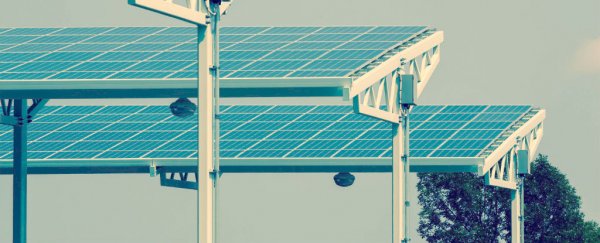As ingenious and environmentally friendly as solar energy solutions are, they're not always as efficient as we'd like them to be - and of course, they're only generating new electricity when the Sun is out. But an international team of scientists has come up with a new type of energy system they're calling 'hydricity', which combines the power of sunlight with hydrogen fuel.
There are two ways we get energy from the Sun: photovoltaic cells (the panels you see on rooftops) and solar thermal power plants, which concentrate the Sun's rays, then use the generated heat to warm up water and drive turbines using the steam that's produced. The latter method captures more of the Sun's solar spectrum, but is less efficient than a standard solar panel, and can only work in direct sunlight - which is why you only find them in parts of the world that get plenty of sunshine.
This is where hydricity comes in. By combining solar thermal power plants with hydrogen fuel production facilities, the researchers say, efficiencies in both types of power can be improved. An integrated system would produce both steam for generating electricity immediately, and hydrogen for storing it for later use - a crucial consideration as the countries of the world become more dependent on renewable energy.
The team, from Purdue University and Switzerland's Federal Polytechnic School of Lausanne, says it can produce hydrogen at an efficiency of 50 percent and electricity at an unprecedented 46 percent efficiency, thanks to the way the high-pressure turbines can be used to run in succession of the lower-pressure ones.
Over the course of an average 24-hour cycle, it's claimed that hydricity could reach a Sun-to-electricity efficiency of 35 percent, which is as good as the best multijunction photovoltaic cells combined with battery power.
The hydrogen fuel produced alongside the electricity is important: not only could it find uses in transportation, chemical production and other industries, it doesn't discharge when stored or degrade with repeated use. When the Sun goes down, the stored hydrogen power could kick in, and that means turbines don't need to be stopped or restarted.
"The concept provides an exciting opportunity to envision and create a sustainable economy to meet all the human needs including food, chemicals, transportation, heating and electricity," said one of the researchers, Rakesh Agrawal from Purdue. "Traditionally, electricity production and hydrogen production have been studied in isolation, and what we have done is synergistically integrate these processes while also improving them."
So far, the scientists have only produced simulated models of the process - the next step is real-world experiments. The group's work has been published in Proceedings of the National Academy of Sciences.
